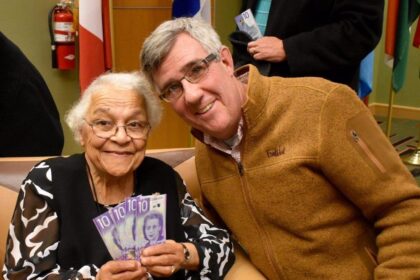ManitobaAn inquest into the hanging death of an inmate at Manitoba’s Stony Mountain Institution says prisons must offer more comprehensive Indigenous programming and do more to help inmates shed the gang-affiliation label.Tyson Roulette’s death cannot be fully understood without considering role of colonialism: inquestCBC News · Posted: Nov 24, 2025 4:01 PM EST | Last Updated: 2 hours agoListen to this articleEstimated 6 minutesThe audio version of this article is generated by text-to-speech, a technology based on artificial intelligence.Tyson Kane Roulette, a high-ranking member of the Indian Posse street gang, was found hanging in his cell on Dec. 8, 2019. (CBC)An inquest into the hanging death of an inmate at Manitoba’s Stony Mountain Institution says prisons must offer more comprehensive Indigenous programming and do more to help inmates shed the gang-affiliation label.That could open doors to a lower security classification, a transfer to a different institution and region, or even parole.Offering up that hope could also “contribute to a better outcome and reduced despair” which often leads to suicide, states the report, filed on Nov. 19.Specifically, it looked at the case of Tyson Kane Roulette, a high-ranking member of the Indian Posse street gang, who was found hanging in his cell on Dec. 8, 2019.He was 34.Roulette began serving a sentence for manslaughter and attempted murder in early 2011. He was assigned to live in a unit where other members of the Indian Posse were housed.He had been a leader of the gang outside of prison and that expanded within the walls but may have led to his despair later, the inquest report from Judge Cynthia A. Devine noted.Roulette became a vice-chair of the Inmate Welfare Committee and was frequently asked by prison officials to assist in mediating conflicts among various gang members, even those in other gangs. He was even consulted with about placement of new inmates, “because he had the pulse of the institution and the various security threat groups” according to one of the nine witnesses to testify at the inquest, held this year from May 12-16 and May 22.If a new inmate owed a drug debt to another gang, the warden would ask Roulette if that inmate could live on the IP range, or if Roulette could speak to members of the other gang about the debt to ease the way for that inmate to be on their range. His mediation efforts, though, enabled Roulette to develop an active drug and criminal operation within the institution. He extracted “rents” from inmates in exchange for protection and ordered a hit on a rival gang member, the report states.“He was running a business within the institution,” according to a witness.But there were also signs Roulette’s association with staff made others consider him a “rat” and put his safety at risk. In the months leading to his death, staff found a “body armor” jacket — lined with newspapers and magazines, to offer protection.Staff also heard rumblings that Roulette was going to be assaulted by “his own guys.” And after his death, a search of his cell uncovered Scrabble letters spelling out “just die already.” Despite his criminal involvement, Roulette had been trying for years to get off the IP range, a witness at the inquest said.Roulette had claimed he was tired of the gang, sought to have that affiliation status dropped by the prison, and tried to get tattoos removed.”That affiliation was never removed during Roulette’s entire time … notwithstanding several attempts. He was not offered any ability to disengage” from that life, the inquest states.And that precluded him from entering Pathways, which is an intensive, elder-driven healing program for Indigenous offenders.Roulette had also started a relationship with a woman who became a regular user of meth and Roulette was hearing from the streets that she was resorting to prostitution to buy her drugs. That, and the possible safety risk, may have fueled his anxiety and distress. Letters expressing that worry were found in his cell after his death.”By Dec. 8, 2019, Tyson Roulette likely believed he had nothing to live for,” states the inquest report. That day he returned to his cell at 7:55 a.m. after a therapy appointment. He never left it again, nor did anyone else enter his cell until some hours after his death, which is believed to have happened at 2 p.m.Roulette’s cell had a blanket hanging as a privacy covering and only twice on their rounds did correctional officers move it aside to peer in, and then only briefly. And only one officer, instead of the required two, had a look.By the time an inmate convinced officers open the cell at 10 p.m., Roulette’s body was in a state of rigor, the report states.Devine’s report says corrective measures have been taken by Stony Mountain with respect to the failure of staff to properly conduct security checks and counts. But there are more things that could be done, and Roulette’s death cannot be fully understood without considering his circumstances as an Indigenous person and the role of colonialism, she wrote.Indigenous programming, with elders and healing lodges should help put an inmates life into context teaching them about the history of Indigenous peoples in their particular area prior to European contact and the making of the treaties, Devine said.And to help inmates exit the gang life, funding must be made available for onsite tattoo removal, while transferring out of institutions should not be so difficult as it was in Roulette’s case, she wrote.”The impasse facing Indigenous inmates involving the interrelationship and sometimes intransigence of their security level was certainly experienced by Roulette.”Further, all inmates, unless they opt out, should be provided full access to Indigenous programing and a healing model, the report says.If you or someone you know is struggling, here’s where to look for help:Canada’s Suicide Crisis Helpline: Call or text 988.Kids Help Phone: 1-800-668-6868. Text 686868. Live chat counselling on the website.Canadian Association for Suicide Prevention: Find a 24-hour crisis centre.This guide from the Centre for Addiction and Mental Health outlines how to talk about suicide with someone you’re worried about.
Monday, 24 Nov 2025
Canada – The Illusion
Search
Have an existing account?
Sign In
© 2022 Foxiz News Network. Ruby Design Company. All Rights Reserved.
You May also Like
- More News:
- history
- Standing Bear Network
- John Gonzalez
- ᐊᔭᐦᑊ ayahp — It happened
- Creation
- Beneath the Water
- Olympic gold medal
- Jim Thorpe
- type O blood
- the bringer of life
- Raven
- Wás’agi
- NoiseCat
- 'Sugarcane'
- The rivers still sing
- ᑲᓂᐸᐏᐟ ᒪᐢᑿ
- ᐅᑳᐤ okâw — We remember
- ᐊᓂᓈᐯᐃᐧᐣ aninâpêwin — Truth
- This is what it means to be human.
- Nokoma












